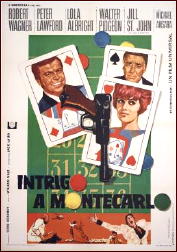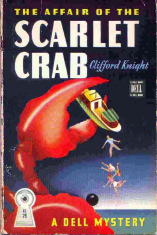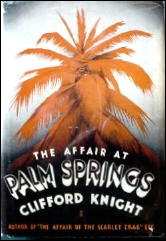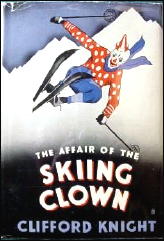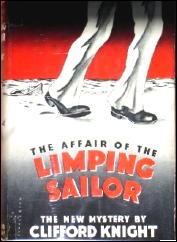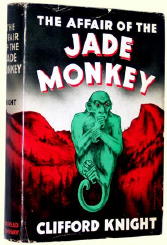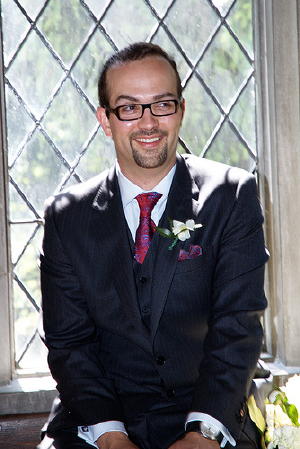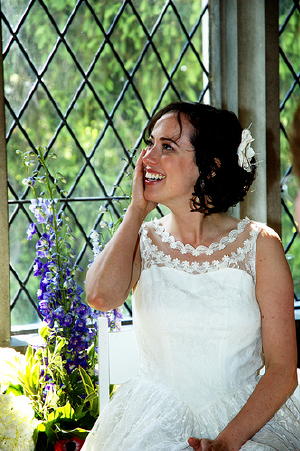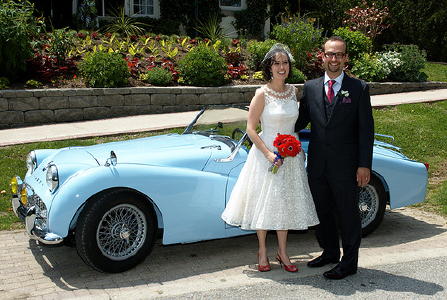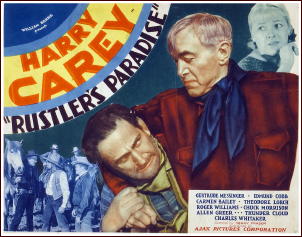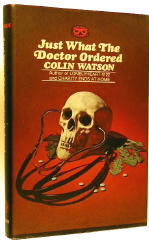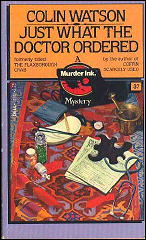THE BACKWARD REVIEWER
William F. Deeck
CLIFFORD KNIGHT – The Affair of the Fainting Butler.
Dodd Mead, hardcover, 1943. Hardcover reprint, Detective Book Club, 3-in-1 edition, November 1943.
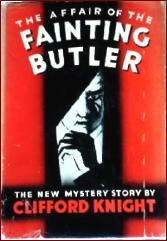
There are those, and I am among them, who read mysteries primarily to find out if the butler did indeed do it. Unfortunately, these days there are few novels in which you can suspect the butler, a breed that has been an endangered and even vanishing species for years.
This is one of the old-fashioned novels that still affords us that pleasure. And, yes, the butler does faint. In fact, he faints three times. Did he do it? That would be telling.
Larry Weeks, agent — or flesh peddler, if you prefer — for Jenifer Janeway, who wrote magazine serials “that made worrying wives, whose husbands had young sophisticated secretaries, think of Reno,” goes to Janeway’s home to try to keep her from carrying out her threat to commit suicide. She is about to start writing screenplays, and she is his meal ticket.
While Janeway and Weeks are in her garden, Sloan Hinckley, Shakespearean actor and Weeks’s other but lesser client, appears on the wall. He is Janeway’s neighbor — ah, coincidence, where would mystery writers be without you? — and has come to report that he has discovered a corpse on her grounds.
No corpse, however, is to be found. When Janeway is visited shortly thereafter by an old friend, Hinckley claims that the old friend was the corpse.
There are several murders of varying unlikelihood for equally unlikely reasons. The amateur detective, Prof. Huntoon Rogers, is a veritable nonentity. Though he is present throughout the novel and solves the crimes, if his name isn’t before you at all times, you tend to forget his existence.
– From The MYSTERY FANcier, Vol. 10, No. 3, Summer 1988.
[EDITORIAL COMMENT.] You can google Huntoon Rogers, Clifford Knight’s detective character, all you want, but you won’t find much out about him. He’s about as anonymous as Bill Deeck suggests, especially considering he was the leading character in 18 of Knight’s detective novels in an 11-year period between 1937 and 1947, all of which began with The Affair of …
But think about it. Eighteen books in eleven years. That’s a pretty good track record for an author and a series character both of whom are all but forgotten now. (I read one once, and I can’t even tell you now which one of them it was.)
Bibliographic data:
Taken from the Revised Crime Fiction IV, by Allen J. Hubin:
ROGERS, PROF. HUNTOON. Series character created by Clifford Knight, 1886-1963.
The Affair of the Heavenly Voice (n.) Dodd 1937 [California]
The Affair of the Scarlet Crab (n.) Dodd 1937 [Ship]
The Affair at Palm Springs (n.) Dodd 1938 [California]
The Affair of the Ginger Lei (n.) Dodd 1938 [Hawaii]
The Affair of the Black Sombrero (n.) Dodd 1939 [Mexico]
The Affair on the Painted Desert (n.) Dodd 1939 [Arizona]
The Affair in Death Valley (n.) Dodd 1940 [California]
The Affair of the Circus Queen (n.) Dodd 1940 [Manila]
The Affair of the Crimson Gull (n.) Dodd 1941 [California]
The Affair of the Skiing Clown (n.) Dodd 1941 [California]
The Affair of the Limping Sailor (n.) Dodd 1942 [California]
The Affair of the Splintered Heart (n.) Dodd 1942 [Hawaii]
The Affair of the Fainting Butler (n.) Dodd 1943 [Los Angeles, CA]
The Affair of the Jade Monkey (n.) Dodd 1943 [California]
The Affair of the Dead Stranger (n.) Dodd 1944 [California]
The Affair of the Corpse Escort (n.) McKay 1946 [Los Angeles, CA]
The Affair of the Golden Buzzard (n.) McKay 1946 [California]
The Affair of the Sixth Button (n.) McKay 1947 [California]
PostScript: You probably do not want to know how much those books in dust jacket would set you back, but I’ll tell you anyway. Excluding the Dell mapback (approximately $15) perhaps mid-three figures each, on the average.
LORNA DOONE. Columbia/Edward Small Productions, 1951. Barbara Hale, Richard Greene, Carl Benton Reid, William Bishop, Ron Randell, Sean McClory, Onslow Stevens, John Dehner. Loosely based on the book Lorna Doone: A Romance of Exmoor (1869) by R. D. Blackmore; adapted by George Bruce. Director: Phil Karlson.
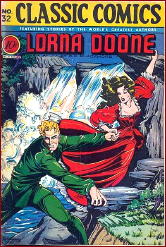
Cramming a long book into a 90-minute movie is not an easy task, but as far I know, the essence of the story is all there. The reason I’m hedging in that last statement is that all I’ve ever read of the book, which has never been out of print, is the comic book version, Classics Illustrated edition (#32), the cover of which I show you here.
I had this comic book for many years, primarily for the cover, I think, but it finally went with the rest of my hoard of Golden Age comics about 15 years ago. I sold most of them off — unfortunately so, as I sorely miss them now.
But speaking of the cover, I didn’t know this when I was young, but it was done by Matt Baker, famed GGA artist of the late 1940s and 50s. GGA stands for Good Girl Art, a statement with which (in Baker’s case) I heartily agree. (And do follow the link. The covers on that site are terrific.)
The story of Lorna Doone takes place in an isolated valley in England in the late 17th century, isolated enough that the Doones rule the area at their whim, taxing the peasants unmercifully and punishing them viciously if they protest — roguish if not utterly outlaw actions which take place unknown to King Charles II.
When John Ridd’s father is killed at the hands of the Doones while he is yet a young lad, he vows revenge. When he is older (and looks like Richard Greene — an obvious choice, the latter later becoming TV’s Robin Hood), he’s also in love with Lorna Doone, the granddaughter of Sir Ensor, the patriarch of the family.
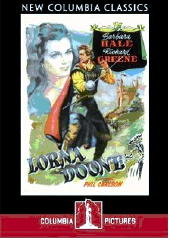
The movie is beautifully filmed — the colors are generally top notch, and the waterfall plunging downward near the Doone castle is rather spectacular — but it’s the actors that often seem to get in the way.
I don’t mean that as disparagingly as it sounds. There’s enough action and romance to satisfy almost anyone who watches, and Barbara Hale (who later became Perry Mason’s Della Street) is as ravishing beautiful as a young royal damsel could be — a perfect replica, I thought, of a Matt Baker drawing.
Otherwise, though, if you were to take another look through the cast, I think you will see as well as I what’s missing: no one of star quality. Workmanlike actors all, but no one with the flair of an Errol Flynn or an Olivia de Havilland (to pick a couple of obvious examples) who might have taken this film a step or two out of the ordinary.
Pleasurable enough then, but still ordinary and not more than mildly satisfying. The book been made into numerable films and various TV movies and mini-series. I’ll try another of them sometime, I think, as well as see if I can’t find another copy of the comic book as nice as the one I had.
IT’S ABOUT CRIME, by Marvin Lachman
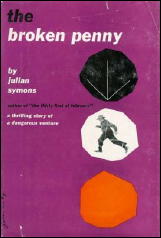
JULIAN SYMONS – The Broken Penny. Victor Gollancz, UK. hardcover, 1953. Harper & Bros., US, hc, 1953*. US paperback reprints include: Dolphin C227, 1960; Beagle, 1971; Perennial Library P480, 1980; Carroll & Graf, 1988*. (* = shown)
Many writers of espionage are content to rely on newspaper stories thinly disguised as fiction, with terrorism and hijacking their stock in trade. Though The Broken Penny (1953), recently reprinted by Carroll and Graf, is flawed, it remains a much more imaginative cold-war thriller.
Telling of the attempt to oust the communist government of a country never named, but apparently based on Poland, Symons provides a devastating picture of people under the totalitarian yoke, but he saves some room to show Britain and the British army in what is not their finest hour.
There is suspense, but mostly The Broken Penny is about the attempt of its protagonist to maintain his Idealism in a world that had gone mad in the early 1950s — and isn’t much saner as I write these words.
– From The MYSTERY FANcier, Vol. 10, No. 3, Summer 1988 (very slightly revised).
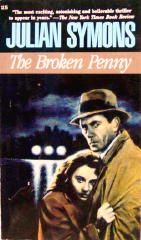
[EDITORIAL COMMENT.] The fellow in the cover of the Carroll & Graf paperback edition looks a lot like Henry Fonda to me. The girl looks familiar as well, but I can’t put a name to the face. This is rather surprising, as there never was a film version of The Broken Penny.
In fact, and what’s even more surprising, is that according to the Revised Crime Fiction IV, of all the mystery novels that Julian Symons wrote, only one of them has ever been made into a movie, that one being The Narrowing Circle (1954; film, 1955).
The detective in that book was Inspector Crambo, who also appeared in The Gigantic Shadow (1958, published in the US as The Pipe Dream). According to IMDB, Trevor Reid played Inspector ‘Dumb’ Crambo in The Narrowing Circle, which also featured Paul Carpenter, Hazel Court and Russell Napier. (And if Hazel Court is in it, then it’s a must find.)
Included in the online Addenda to the Revised Crime Fiction IV, a series episode of Kraft Suspense Theater entitled “Twixt the Cup and the Lip” was based on a short story in the collection How to Trap a Crook and 12 Other Mysteries.
But it looks as though I’ll have to tell Al Hubin about this: According to IMDB, the following Symons novels were also turned to movies:
Criss Cross Code (*) as Counterspy.
The Man Who Killed Himself as Arthur! Arthur!
The Blackheath Poisonings, as a 3-part miniseries.
[??] as Die Spur führt ins Verderben. (**)
(*) This is not a novel, but a perhaps uncollected novelette first published in Lilliput, Aug-Sept 1951. (**) According to Babel Fish, a direct translation is “The trace leads into spoiling.”
[UPDATE] 06-17-09. Al Hubin has agreed that items 2 and 3 should be in CFIV, and the first also, but only if “Criss Cross Code” appeared in a Symons story collection, perhaps in retitled form.
Also, in the comments, Steve W. has pointed out that The Thirty-First of February “was made into what I remember to be a quite good episode of the Alfred Hitchcock Hour.”
True. It was, and I missed it when I was researching Symons on IMDB last night. Date: 4 January 1963, and as Steve advised me in a followup email, “the whole season is available at Hulu. Here’s the link to the Symons adaptation: HULU: 31st of February.”
So far, I’ve managed to stay away from Hulu. I spend too much time at the computer as it is, and to start watching TV here at my desk might mean never getting anything done. Nonetheless, there might be a possibility of exceptions being made. Maybe now and then?
A REVIEW BY DAVID L. VINEYARD:
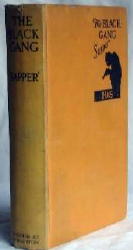
H. C. McNEILE [SAPPER] – The Black Gang.
Hodder & Stoughton, UK, hardcover, 1922, as by “Sapper.” Doubleday Doran & Co., US, hardcover, 1922. Reprinted many times in both hardcover and soft. Filmed as The Return of Bulldog Drummond: BIP, 1934, screenwriter/director: Walter Summers.
Readers should be warned that I am going to write a positive review of one of the most excoriated books in the thriller genre, and I should know since I have been among those excoriating it. That said, I think someone needs to point out why Sapper (Herman Cyril McNeile) and Bulldog Drummond have lingered so long in the public imagination and are still read today by some — myself included.
The reasons aren’t just historical nor the relative low state of the public taste, and there are reasons Drummond inspired writers like Ian Fleming and Clive Cussler, not to mention Lester Dent and Doc Savage, Mickey Spillane and Mike Hammer, Leslie Charteris and the Saint, and John Creasey and Patrick Dawlish.
There is more going on here than just a brief popular phenomena. Today the name still has a certain evocation, a fact expressed by it’s use by a well known design firm and it’s presence in the rock lyrics of the band the Coasters in their 1957 song “Searchin!”
No matter where she’s a-hidin’, she’s gonna hear me a-comin’
Gonna walk right down that street like Bulldog Drummond!
Sapper was one of the writers critic and journalist Richard Usborne defined as “The Clubland Heroes,” in his book of that name, a study of Dornford Yates, Sapper, and John Buchan’s novels about West End club men heroes of a particular brand of thriller (or shocker as Buchan preferred) that was popular in the period between WWI and WWII. (Buchan, it should be noted, began as early as 1910).
Sapper began his career writing in the Kipling mode (which he never fully escaped) in short stories set in the trenches of WWI France. His popular collections of short fiction exemplified the British soldier and particularly the upper middle class Englishman, a sportsman who for some tragic reason might be an ordinary ranker or perhaps an officer, and become involved in some dramatic wartime incident (and following Kipling’s lead from the Soldier’s Three stories, a fair number of comic ones). At the site devoted to the artwork on the dust jackets of books about the Great War (I) an entire page is devoted to Sapper.
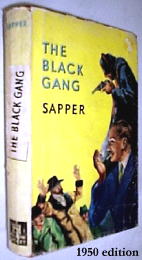
At the war’s end McNeile returned to England, and like many men in his position he was dissatisfied and found it difficult to readjust. He probably didn’t feel the general malaise and depression many veterans did, he just wasn’t the type, but it was a result of his war experience and disillusion with civilian life that he wrote his 1920 novel Bulldog Drummond: the Story of a Demobilized Officer Who Found Peacetime Dull.
Captain Hugh “Bulldog” Drummond is a large cheerfully ugly type (with beautiful eyes and a charming smile) who indeed finds peacetime dull, so from his flat in Half Moon Street in London’s fashionable West End he takes out an ad advertising his services.
… “Demobilized officer,” she read slowly, “finding peace incredibly tedious, would welcome diversion. Legitimate, if possible; but crime, if of a comparatively humorous description, no objection. Excitement essential. Would be prepared to consider permanent job if suitably impressed by applicant for his services. Reply at once Box X10.”
The ad brings one Phyllis Benton (of the golden brown curls), a lady in distress whose father is being held by mysterious men. And we’re off. Soon Drummond is joined by his friends Peter Darrell (second in command), Algy Longworth (silly ass), Ted Jerringham (�a good amateur actor”) and Toby Sinclair (V.C. no less).
As Usborne points out it is the world of the public school scrum with beer and martinis. (Sapper had obviously read his Baroness Orczy, for the lads sound an awful lot like the League of the Scarlet Pimpernel and much of Drummond’s drawling and babbling is drawn from the Pimpernel himself, Sir Percy Blakeney.) An entire generation of young Englishmen had died in the trenches of the Great War, and in the adventures of Drummond and his friends they were reborn in the popular imagination.
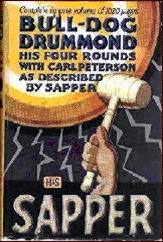
But as in the public school scrum there is the ‘enemy’, and here Sapper outdoes himself, for in his first four adventures Drummond is opposed by one of the great villains in popular literature, a figure of cunning and cold intellect who could give Moriarity and Fu Manchu a run for their money and was the inspiration for Ian Fleming’s James Bond’s ultimate rival Ernst Stavro Blofield of Spectre, namely Carl Peterson.
Indeed Peterson is such a good villain Usborne gives him his own chapter in The Clubland Heroes, the only villain to earn such an honor, or deserve it.
And if Peterson isn’t enough Sapper outdoes himself by giving him an adoring and worshipful black widow of a mistress, Irma Peterson, the slinkiest deadliest and most evil companion in the literature. If Peterson didn’t consistently overestimate Drummond’s intelligence and always fail to plan for the most obvious action it is pretty clear our hero would never have had a chance. He’s outmatched by a mile.
There’s a plot in progress to bring ruin not just to Phyllis’s father, but the entire British economic system. Before it’s over Drummond will have strangled a full grown ape in a pitched battle in the dark, played commando assaulting Peterson’s stronghold, and tossed Peterson’s second in command Henry Lakington into a much deserved acid bath. (�The retribution is just.”)
England is saved, Peterson and Irma escape, and Drummond marries Phyllis, who has already begun her notable career of being the most kidnapped wife in literature. (The Spider’s companion Nita Van Sloan may have outdone Phyllis, but then she wasn’t a wife.)
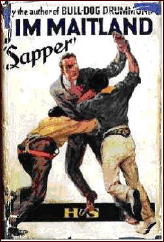
Sapper may not have been subtle, but he had a fine eye for melodrama. Bulldog Drummond was an immediate success and there was little doubt he would be back, although between the first and second books Sapper produced a series of connected stories about another hero, monocled Jim Maitland.
Jim Maitland (1921) is probably Sapper’s best book and best character, but in this article slash review we are involved with Drummond, and his second adventure, The Black Gang, the latter referring to Drummond’s black-hooded and black leather clad team of self-styled vigilantes who have been terrorizing the criminal element in England in the period before the novel begins.
The focus of the book is another plot against England that’s afoot at Carl Peterson’s hands. (He’s now disguised as “a splendid example of the right sort of clergyman, tall, broad shouldered, with a pair of shrewd, kindly eyes.”)
This time Carl is behind a phony peace movement and in league with actual Bolsheviks, including the murderous Yulowski who has brought to England with him the very rifle with which he clubbed the Romanov royals to death. (Before it’s over Drummond and Phyllis will only just escape the same fate with the royally blooded rifle.) Nothing less than a Communist Revolution in England is at hand.

Meanwhile Sir Bryan Johnstone, the Yard’s Director of Criminal Investigation and Chief Inspector MacIver are getting nowhere with a mysterious group of ruffians in black leather and hoods who have been making hay with London’s less social class of criminals.
White slavers, pimps (though implied, never mentioned obviously), usurers, and the like have been disappearing, and when they do show up again keeping silence after some decidedly rough treatment that has shown them the error of their ways, while the Reds are up to something.
In the meantime, if things aren’t bad enough for Hugh Drummond, the boy who had been Johnstone’s fag at school (and no, it doesn’t have the same meaning in England) shows up on his door burbling nonsense.
Before it’s over Drummond will just miss being blown up by a grenade (the fellow beside him gets blown to gory bits — it hardly puts Drummond off his beer or his feed though), and just misses being poisoned by a Borgia poison in a doyley at the Ritz, not to mention that Russian rifle butt that once graced royal skulls. Drummond and Phyllis are captured, Carl takes the time to gloat:
“Eminently satisfactory, my friend, eminently. And when your dear wife returns from the country–if she does — well, Captain Drummond, it will be a very astute member of Scotland Yard who will associate her little adventure with that benevolent old clergyman, the Reverend Theodosius Longmoor, who recently spent two or three days at the Ritz. Especially in view of your kindly telephone message to Mr. — what’s his name? — Mr. Peter Darrell?”
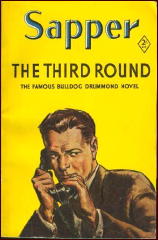
He glanced at his watch and rose to his feet. “I fear that that is all the spiritual consolation that I can give you this evening, my dear fellow,” he remarked benignly. “You will understand, I’m sure, that there are many calls on my time. Janet (Irma), my love” — he raised his voice — “our young friend is leaving us now. I feel sure you’d like to say good-bye to him.”
She came into the room, walking a little slowly and for a while she stared in silence at Hugh. And it seemed to him that in her eyes there was a gleam of genuine pity. Once again he made a frantic effort to speak–to beg, beseech, and implore them not to hurt Phyllis — but it was useless. And then he saw her turn to Peterson.
“I suppose,” she said regretfully, “that it is absolutely necessary.”
“Absolutely,” he answered curtly. “He knows too much, and he worries us too much.”
She shrugged her shoulders and came over to Drummond. “Well, good-bye, mon ami,” she remarked gently. “I really am sorry that I shan’t see you again. You are one of the few people that make this atrocious country bearable.”
Of course Drummond does escape, foils Peterson’s plot, and rescues Phyllis, he even convinces Scotland Yard that the Black Gang has played an important role in the deadly doings. He also spares Peterson’s life at Phyllis insistence:
And then she saw her husband bending Carl Peterson’s neck farther and farther back, till at any moment it seemed as if it must crack. For a second she stared at Hugh’s face, and saw on it a look which she had never seen before–a look so terrible, that she gave a sharp, convulsive cry.
“Let him go, Hugh: let him go. Don’t do it.”
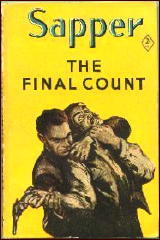
To be fair, Phyllis is less concerned about Peterson than the inhuman rage her husband is in, having moments before pinned the murderous Yulowski to the wall with his own bayonet like a giant butterfly on cardboard. Carl won’t be quite so lucky two books later in The Final Count, when he meets his end at Drummond’s hands in an airship (the Megalithic) over London.
“If you won’t drink � have it the other way, Carl Peterson. But the score is paid.”
His grip relaxed on Peterson’s throat: he stood back, arms folded, watching the criminal. And whether it was the justice of fate, or whether it was that previous applications of the antidote had given Peterson a certain measure of immunity, I know not. But for full five seconds did he stand there before the end came. And in that five seconds the mask slipped from his face, and he stood revealed for what he was. And of that revelation no man can write…
Richard Usborne thinks Sapper blows this moment, which he humorously attributes to the narrator of the story, but I agree with Kingsley Amis in his book on James Bond, The James Bond Dossier. It is Sapper at his most powerful.
The plot is averted, and the Black Gang retired, but they wait, they wait. Irma comes back in the fifth book, The Female of the Species, for revenge (Phyllis gets kidnapped again, and kills her first man with a spanner) and then off and on for the rest of the series, well into the ones written by Sapper’s successor Gerard Fairlie (who was a better writer overall, and the actual model for Drummond as well as an actual secret agent who operated behind enemy lines in WWII). The latter even brought the Black Gang back in the last Drummond novel, The Return of the Black Gang (1952), but in a much more politically correct fashion.
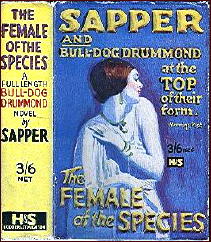
Now, what was so objectionable? Well, in The Black Gang maybe it’s the constant harping on the clique of murderous Russian Jews who killed the Tsar, or the flashy types who are in the white slavery business, or maybe it’s the little island the Black Gang have set up where an ex-sergeant major and some demobilized officers have set up a concentration camp for these low types — Jews and foreigners and other less attractive sorts — where they have been taught the error of their ways with a bullwhip and the boot.
Fortunately this happens offstage, but it is difficult for a modern reader to read this passage without visions of jackboots and SS uniforms. But the fault is history’s and not Sapper’s. If we apply the same standards, Mickey Spillane only fares a little better.
And look at it this way. In England where there was the outlet of popular literature this only happened in a book, and only to actual criminals, not ordinary people, and no women or children or innocents. In Germany where there was no real tradition of this kind of thriller literature to speak of; it happened in the streets and people looked away or pretended it wasn’t happening.
Some, there, and here, still pretend it didn’t happen today, but while the attitudes of the Drummond books and others may not be enlightened, it isn’t fair to brand them as would-be storm troopers either.
By the standards of the day Sapper is only a minor offender. It takes Sydney Horler or M.P. Shiel to really be offensive. Sapper was at worst only aping popular sentiments and opinions that, however despicable, need to be viewed in historical perspective. This is not an apologia for him or others, only a perspective.
If you can’t overlook or understand the limits of older popular fiction then you probably would do best to avoid it.
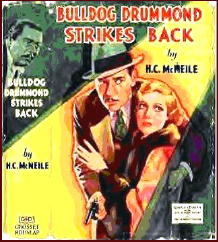
By its very nature popular fiction reflects popular views, and luckily as time passes we progress, slowly, in our recognition of our prejudices and failures. Popular fiction is at worst a bellwether, not a clarion call to action.
No apology, it’s nasty stuff, but it isn’t quite as bad as it sounds. The Black Gang was written in 1922, long before the horrors of the Holocaust and at a time when ‘concentration camp’ only referred to the prisons where Boers had been held in the Boer War.
The casual Anti-Semitism of the book was fairly standard in popular fiction of the day. (It even shows up a little in Buchan, who was not the least anti-Semitic and indeed an early voice to warn of Fascism.) This is before Mussolini and his Blackshirts, well before Hitler and the Brownshirts, and still several years out from Sir Oswald Mosely and his own Black Gang of would be traitors.
Sapper’s overgrown bully boys aren’t that far off from Sherlock Holmes taking the law into his own hands, the Scarlet Pimpernel’s League, or even the Saint’s war on boredom, just a bit less smooth and suave about it. There is no excuse, but you can’t judge the book or Sapper based on what happened over a decade later. No one really understood, not even the victims, until if was too late.
But judge The Black Gang on its own merits and it is one of the best of the Drummond books. The incidents are exciting, Drummond is probably at his most attractive (and least annoying), and as a thriller it is first rate entertainment. There are some splendid set pieces such as when Peterson’s men are hunting Drummond who picks them off one by one in the dark, and the final confrontation with Yulowski and Peterson, and in Drummond’s defense Peterson’s victims number in the hundreds.
Carl may be a charming monster, but he’s a monster none the less, who plots to overthrow England for nothing more than his own financial improvement and a distaste for England and the English. Carl believes in nothing but Carl and is loyal to no cause but his own.
The Black Gang came to the screen as The Return of Bulldog Drummond (not based on the book of that name) with Ralph Richardson as Drummond and Francis L. Sullivan a fine Peterson.
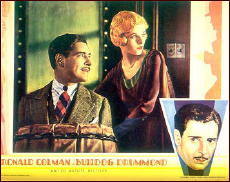
The Black Gang was present in black leather and on motorbikes, but some of the less appealing aspects of the book were left off. It’s not a bad little movie, and Richardson is quite good (ironically he plays the villain in the spoof Bulldog Jack penned by Sapper and Gerard Fairlie) looking forward to the role in Q Planes (Clouds Over Europe) where his suave British agent would inspire the creation of John Steed of the Avengers.
Drummond found his way to the screen as early as the silents, but it was 1929’s talkie Bulldog Drummond with Ronald Colman as Drummond, Joan Bennett as Phyllis, and Montagu Love as Peterson that really put the character in the public eye. It seems strange today when we note Colman was nominated for an Academy Award playing Drummond (stranger still that he was beaten by Warner Baxter in In Old Arizona playing the Cisco Kid).
Temple Tower (a lost film), The Return of …, and Bulldog Drummond At Bay (with American John Lodge coming physically closest to Sapper’s interpretation of Drummond) followed, but it’s 1934’s Bulldog Drummond Strikes Back that inspired the series that followed.
Ronald Colman was again Drummond, Charles Butterworth a droll Algy (and Ona Munson his long suffering bride), Loretta Young the lady in danger, Sir C. Aubrey Smith Colonel Neilson Drummond’s friend at the Yard, and no less than Charlie Chan and Fu Manchu Warner Oland as an Egyptian prince involved in dastardly doings.
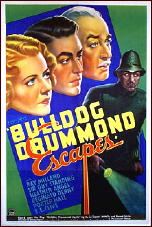
It is one of the brightest mystery comedies of an age when the form was at its peak and still holds up today thanks to fine performances, direction, and script. It was also a big hit and inspired a series of B films. The first was Bulldog Drummond Escapes with Ray Milland as Drummond, but the series proper featured John Howard (who played Colman’s younger brother in Frank Capra’s Lost Horizon), Reginald Denny as Algy, E. E. Clive as Drummond’s servant Tenny (changed from Denny in the novels for obvious reasons), and John Barrymore as Neilson (eventually replaced by veteran H.B. Warner).
A running gag had Drummond’s pending marriage to Phyllis (Louise Campbell and later Heather Angel) always being put off by his latest adventure. The series was well produced and written, and had a fine array of villains including George Zucco, Porter Hall, Leo G. Carroll, Anthony Quinn, and Eduardo Cianelli.
When the Howard series ended Tom Conway and Ron Randell each did two Drummond films, and in 1951, Victor Saville did an A picture, Calling Bulldog Drummond, based on one of Fairlie’s books (and written by him) with Walter Pidgeon as Drummond and a supporting cast that included David Tomlinson (Father in Mary Poppins) as Algy, Margaret Leighton as an undercover policewoman, Robert Beatty (who would play Drummond in a television pilot aired on the Douglas Fairbanks Jr,. Show) as a gangster, and James Bond’s future M, Bernard Lee in a key role.
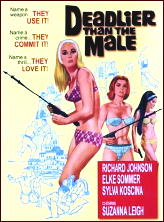
Save for the television pilot Drummond lay in doggo until 1966 when he was revived for two Bondish outings starring Richard Johnson as an updated Drummond, Deadlier Than the Male and Some Girls Do. Both films are fun, with a deadly game of chess on a giant board an excellent set piece in the first one, and Nigel Green outstanding as Peterson. (James Villiers is only a little less perfect in the second film.) Elke Summer and Sylvia Koscina in the first and Daliah Lavi in the second are Peterson’s murderous cohorts.
Drummond also had a long and successful career on radio (�Out of the fog, out of the night …”) in a series starring Santos Ortega and Sir Cedric Hardwicke. In 2006 Moonstone Comics brought Drummond back in a comic book written by William Messner Loebs in which Drummond becomes a sort of private detective and we discover Phyllis and Irma are one and the same.
It’s a terrific little adventure that remains true to Sapper’s Drummond while updating many aspect of the story. Drummond also features in Kim Newman’s second book in his Anno Dracula trilogy, The Bloody Red Baron, as a nasty vampire, and a psychotic violent old prig in the third volume of Alan Moore’s graphic novel series The League of Extraordinary Gentleman.
Seems you can’t keep a good — or bad — man down. There is even a play and movie by Alan Shearman, Bullshot Crummond, that is a dead on send up of all things Drummond.
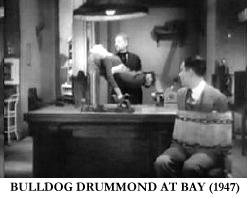
Drummond has been around close to ninety years now, and is still going fairly strong. The name still evokes foggy roads, low slung speeding sports cars, dastardly villains, and dangerous adventure with pitched battles in which the fate of nations is at stake.
Leslie Charteris modeled the early Saint on Drummond (but he was a much better writer) and Doc Savage and his crew owe more than at little to Drummond and his.
Mickey Spillane was a fan, as was Ian Fleming. (British traitor Guy Burgess supposedly observed that James Bond was Bulldog Drummond to the waist and Mike Hammer from the waist down.) More recently Clive Cussler has mentioned Drummond as a major influence on Dirk Pitt. When Paul Gallico reviewed Casino Royale he called James Bond “Bulldog Drummond with brains.”
The first seven books in the Drummond series (Bulldog Drummond, The Black Gang, The Third Round, The Final Count, Female of the Species, The Return of Bulldog Drummond, and Temple Tower can be found online in free ebook editions with a little searching.
Jim Maitland, and at least three of the short story collections are available too. The Howard films are easy (and inexpensive) to find on DVD, Deadlier Than the Male and Some Girls Do are a bit more expensive but also available in handsome DVD packages.
The pilot film with Robert Beatty can be found on some sets of old television detective series. Calling Bulldog Drummond often shows up on TCM as it was an MGM film. Most of the others can be found on the gray market with the exception of Temple Tower and the silent Drummonds.
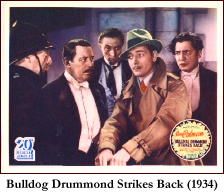
The first Colman film is in public domain and can be downloaded direct to your PC. Several old-time radio sites offer free episodes of the radio series you can listen to or download, and cassettes and CDs of many episodes are available as well.
The Fairlie books, some of which were not published in the United States, are a bit harder to find than the original Sapper books, but none of them are really all that difficult with a little effort. There are also five Drummond short stories (the best known being “The Thirteen Lead Soldiers” basis for one of the Conway films) collected for the first time in The Best Short Stories By Sapper.
Bulldog Drummond is still with us. He can be a bit noisy, and he has a tendency to blather in the way of heroes of his era, but he’s good company on an adventure where the stakes are high and the odds are dicey.
Before you dismiss him you might keep in mind that half the books on the shelves of the mystery and thriller genre owe something to him. He’s a bit like one of those uncles that you love, but sometimes hate to admit you are related to. But bless him or damn him, he’s one of the family, and the resemblance can’t be denied.
